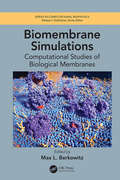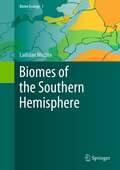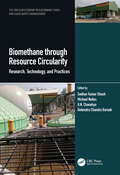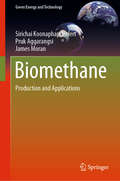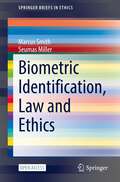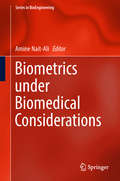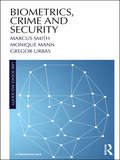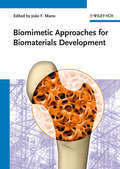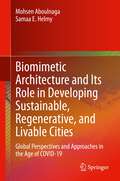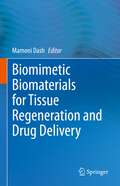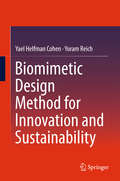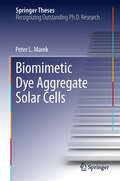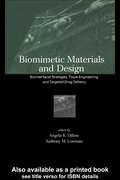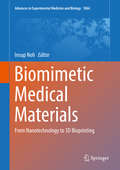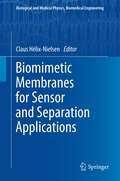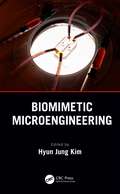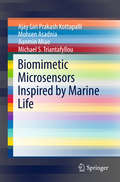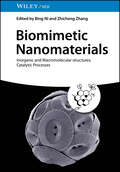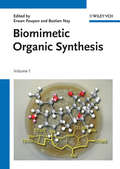- Table View
- List View
Biomembrane Protocols, I. Isolation and Analysis: I. Isolation and Analysis (Methods in Molecular Biology #19)
by Joan A. Higgins John M. GrahamExpert practitioners combine the traditional basic techniques of membrane isolation and analysis with modern advances in molecular biology, immunology, and clinical sciences to devise analytical techniques that are successful for expert and novice alike. The techniques are used in the isolation and compositional analysis of membranes and address animal, plant, and microbial cells. The topics covered in this first volume include the isolation of subcellular fractions, centrifugation, the extraction and quantitation of lipids, the separation and analysis of proteins, and the isolation and characterization of glycosylated molecules, glycoproteins, proteoglycans, and glycolipids.
Biomembrane Simulations: Computational Studies of Biological Membranes (Series in Computational Biophysics)
by Max L. BerkowitzDue to recent advancements in the development of numerical algorithms and computational hardware, computer simulations of biological membranes, often requiring use of substantial computational resources, are now reaching a mature stage. Since molecular processes in membranes occur on a multitude of spatial and time scales, molecular simulations of membranes can also serve as a testing ground for use of multi-scale simulation techniques. This book addresses some of the important issues related to understanding properties and behavior of model biological membranes and it Shows how simulations improve our understanding of biological membranes and makes connections with experimental results. Presents a careful discussion of the force fields used in the membrane simulations including detailed all-atom fields and coarse-grained fields. Presents a continuum description of membranes. Discusses a variety of issues such as influence of membrane surfaces on properties of water, interaction between membranes across water, nanoparticle permeation across the membrane, action of anesthetics and creation of inhomogeneous regions in membranes. Discusses important methodological issues when using simulations to examine phenomena such as pore creation and permeation across membranes. Discusses progress recently achieved in modeling bacterial membranes. It will be a valuable resource for graduate students, researchers and instructors in biochemistry, biophysics, pharmacology, physiology, and computational biology.
Biomes of North America: A Walk In The The Prairie
by Rebecca L. JohnsonTake a walk through the prairie. This biome of tall grass and open sky is teeming with life. How do the plants and animals of the prairie survive? As you travel through the prairie, watch closely to understand how each living creature is part of a circle of life.
Biomes of the Southern Hemisphere (Biome Ecology #1)
by Ladislav MucinaThis is the first comprehensive and critical evaluation of the biome (large-scale, functional biotic communities) patterns in the Southern Hemisphere. Revising the Heinrich Walter's zonobiome system for the Southern Hemisphere appeared as necessary because of the bioclimatic imbalance between the Hemispheres. This revision resulted in formulation of a new zonobiome system, considering the geographic peculiarities of both Hemispheres, hence creating a new, powerful tool of global nature-resource survey and conservation. The system has a potential to attract the interest of the global climate modeling community as the concept of biome (and associated hierarchical system) has a strong functional focus. All zonal biomes of the Southern Hemisphere are featured, and the major challenges we face in understanding their origins, structure, and functioning are discussed. The book contains a wealth of original data resulting from collation of bioclimatic data and vegetation mapping.
Biomethane through Resource Circularity: Research, Technology and Practices (The Circular Economy in Sustainable Solid and Liquid Waste Management)
by Sadhan Kumar Ghosh H. N. Chanakya Debendra Chandra Baruah Michael M. NellesBiomethane through resource circularity: Research, Technology and Practices is an invaluable resource for researchers, policy makers, implementers and PhD and Marsters level students in universities analyzing the present status, waste biomass including agro wastes, success in experimentation & commercial production, future needs and other relevant areas. While huge biomass is wasted by open burning, there is potential of energy generation that can be extracted from the biomass preventing GHG emission and creating business opportunities. Abundance and renewable bioenergy can contribute to a more secure, sustainable, and economically sound future through biomethanation process by selecting followings: Supply chain sustainability of clean energy sources Appropriate Anaerobic Digestion technology with different feedstock Processes Parameter Optimization and best fit conditions, Productivity, Purification of biogas and end use Economic feasibility as business case, Commercialization, generating employment and Revitalizing rural economies This book addresses most of the above issues in lucid manner by experts in the field from different countries which are helpful for the related stakeholders edited by experts in the field.
Biomethane: Production and Applications (Green Energy and Technology)
by James Moran Sirichai Koonaphapdeelert Pruk AggarangsiThis book discusses biomethane and the processes and applications downstream from biogas production. Biogas is a result of anaerobic digestion of agricultural or general household waste, such as manure, plants or food waste, and as such is considered a renewable energy source. Biomethane is a gas that results from any process that improves the quality of biogas by reducing the levels of carbon dioxide, hydrogen sulfide, moisture and other contaminant gases. Chemically, biomethane is the same as methane, and its name refers to the method of production rather than the content. Biomethane plants are generally found in locations with a low population density that are close to farms or food processing plants. In situations where there is no natural gas pipeline nearby, biomethane downstream applications can include storage, transportation, home heating, industrial use and distribution through small-scale local gas grids. This book discusses each of these applications and lists some of the design criteria as well as various issues relating to them.
Biometric Identification, Law and Ethics (SpringerBriefs in Ethics)
by Seumas Miller Marcus SmithThis book is open access. This book undertakes a multifaceted and integrated examination of biometric identification, including the current state of the technology, how it is being used, the key ethical issues, and the implications for law and regulation. The five chapters examine the main forms of contemporary biometrics–fingerprint recognition, facial recognition and DNA identification– as well the integration of biometric data with other forms of personal data, analyses key ethical concepts in play, including privacy, individual autonomy, collective responsibility, and joint ownership rights, and proposes a raft of principles to guide the regulation of biometrics in liberal democracies.Biometric identification technology is developing rapidly and being implemented more widely, along with other forms of information technology. As products, services and communication moves online, digital identity and security is becoming more important. Biometric identification facilitates this transition. Citizens now use biometrics to access a smartphone or obtain a passport; law enforcement agencies use biometrics in association with CCTV to identify a terrorist in a crowd, or identify a suspect via their fingerprints or DNA; and companies use biometrics to identify their customers and employees. In some cases the use of biometrics is governed by law, in others the technology has developed and been implemented so quickly that, perhaps because it has been viewed as a valuable security enhancement, laws regulating its use have often not been updated to reflect new applications. However, the technology associated with biometrics raises significant ethical problems, including in relation to individual privacy, ownership of biometric data, dual use and, more generally, as is illustrated by the increasing use of biometrics in authoritarian states such as China, the potential for unregulated biometrics to undermine fundamental principles of liberal democracy. Resolving these ethical problems is a vital step towards more effective regulation.
Biometric Recognition: 11th Chinese Conference, CCBR 2016, Chengdu, China, October 14-16, 2016, Proceedings (Lecture Notes in Computer Science #9967)
by Jie Zhou Shiguang Shan Zhisheng You Yunhong Wang Zhenan Sun Weishi Zheng Jianjiang Feng Qijun ZhaoThis book constitutes the refereed proceedings of the 11th Chinese Conference on Biometric Recognition, CCBR 2016, held in Chengdu, China, in October 2016. The 84 revised full papers presented in this book were carefully reviewed and selected from 138 submissions. The papers focus on Face Recognition and Analysis; Fingerprint, Palm-print and Vascular Biometrics; Iris and Ocular Biometrics; Behavioral Biometrics; Affective Computing; Feature Extraction and Classification Theory; Anti-Spoofing and Privacy; Surveillance; and DNA and Emerging Biometrics.
Biometric State
by Keith BreckenridgeGroundbreaking study of South Africa's role as a site for global experiments in biometric identification throughout the twentieth century.
Biometrics under Biomedical Considerations (Series in BioEngineering)
by Amine Nait-Ali<p>This book addresses biometrics from a biomedical engineering point of view. Divided into five sections, it discusses topics including the influence of pathologies on various biometric modalities (e.g. face, iris, fingerprint), medical and security biometrics, behavioural biometrics, instrumentation, wearable technologies and imaging. The final chapters also present a number of case studies. <p>The book is suitable for advanced graduate and postgraduate students, engineers and researchers, especially those in signal and image processing, biometrics, and biomedical engineering.</p>
Biometrics, Crime and Security (Law, Science and Society)
by Marcus Smith Monique Mann Gregor UrbasThis book addresses the use of biometrics – including fingerprint identification, DNA identification and facial recognition – in the criminal justice system: balancing the need to ensure society is protected from harms, such as crime and terrorism, while also preserving individual rights. It offers a comprehensive discussion of biometric identification that includes a consideration of: basic scientific principles, their historical development, the perspectives of political philosophy, critical security and surveillance studies; but especially the relevant law, policy and regulatory issues. Developments in key jurisdictions where the technology has been implemented, including the United Kingdom, United States, Europe and Australia, are examined. This includes case studies relating to the implementation of new technology, policy, legislation, court judgements, and where available, empirical evaluations of the use of biometrics in criminal justice systems. Examples from non-western areas of the world are also considered. Accessibly written, this book will be of interest to undergraduate, postgraduate and research students, academic researchers, as well as professionals in government, security, legal and private sectors.
Biometry: Technology, Trends and Applications
by Ricardo A. Ramirez-Mendoza, Jorge de J. Lozoya-Santos, Ricardo Zavala-Yoé, Luz María Alonso-Valerdi, Ruben Morales-Menendez, Belinda Carrión, Pedro Ponce Cruz and Hugo G. Gonzalez-HernandezBiometrics provide quantitative representations of human features, physiological and behavioral. This book is a compilation of biometric technologies developed by various research groups in Tecnologico de Monterrey, Mexico. It provides a summary of biometric systems as a whole, explaining the principles behind physiological and behavioral biometrics and exploring different types of commercial and experimental technologies and current and future applications in the fields of security, military, criminology, healthcare education, business, and marketing. Examples of biometric systems using brain signals or electroencephalography (EEG) are given. Mobile and home EEG use in children’s natural environments is covered. At the same time, some examples focus on the relevance of such technology in monitoring epileptic encephalopathies in children. Using reliable physiological signal acquisition techniques, functional Human Machine Interfaces (HMI) and Brain-Computer Interfaces (BCI) become possible. This is the case of an HMI used for assistive navigation systems, controlled via voice commands, head, and eye movements. A detailed description of the BCI framework is presented, and applications of user-centered BCIs, oriented towards rehabilitation, human performance, and treatment monitoring are explored. Massive data acquisition also plays an essential role in the evolution of biometric systems. Machine learning, deep learning, and Artificial Intelligence (AI) are crucial allies here. They allow the construction of models that can aid in early diagnosis, seizure detection, and data-centered medical decisions. Such techniques will eventually lead to a more concise understanding of humans.
Biomimetic Approaches for Biomaterials Development
by Joao F. ManoBiomimetics, in general terms, aims at understanding biological principles and applying them for the development of man-made toolsand technologies. This approach is particularly important for the purposeful design of passive as well as functional biomaterials that mimicphysicochemical, mechanical and biological properties of natural materials, making them suitable, for example, for biomedical devices oras scaffolds for tissue regeneration.The book comprehensively covers biomimetic approaches to the development of biomaterials, including: an overview of naturally occurringor nature inspired biomaterials; an in-depth treatment of the surface aspects pivotal for the functionality; synthesis and self-assemblymethods to prepare devices to be used in mineralized tissues such as bone and teeth; and preparation of biomaterials for the controlled/sustained release of bioactive agents. The last part reviews the applications of bioinspired materials and principles of design in regenerativemedicine such as in-situ grown bone or cartilage as well as the biomimetic techniques for soft tissue engineering.The comprehensive scope of this book makes it a must-have addition to the bookshelf of everyone in the fields of Materials Science/Engineering, Nanotechnologies / Nanosciences, Medical Sciences, Biochemistry, Polymer Chemistry, and Biomedical Engineering.
Biomimetic Architecture and Its Role in Developing Sustainable, Regenerative, and Livable Cities: Global Perspectives and Approaches in the Age of COVID-19
by Mohsen Aboulnaga Samaa E. HelmyThis book focuses on understanding biomimetic architecture and its role as a sustainable design tool. It presents the role of biomimicry in mitigation and adaptation to climate change and examines how biomimetic architecture can provide healthy solutions to limit the spread of COVID-19 in buildings and cities. Coverage includes global examples of biomimetic approaches and buildings, an evaluation of the performance of biomimicry applications in architecture to illustrate best practices, and an exploration of how nature can offer inspiration in building design to conserve resources and save energy use as well as curb carbon emissions – a reaffirmed goal of COP 26 and an outcome of Glasgow Climate Pact. Finally, the book presents guidelines to enhance urban areas and healthier spaces in buildings to meet COVID-19 social distance regulations and beyond.Examines global applications of biomimicry in architecture;Highlights the importance of biomimicry in driving livability in cities and buildings;Explores the role of biomimetic architecture in mitigating climate change.“The line of argument developed is highly relevant to the present, in addition to being original and pertinent to research on urban regeneration, especially in regard to the exploration of the use of biomimicry architecture in response to changing urban demands.” —Alessandra Battisti, Ph.D., Professor of Architecture, University of Rome La Sapienza-
Biomimetic Biomaterials for Tissue Regeneration and Drug Delivery
by Mamoni DashThis book illustrates the influence of biomimetics in the field of tissue engineering and drug delivery. These two distinct fields of regenerative medicine have greatly benefited from the concept of biomimetics, which focuses on using or imitating nature to develop materials for improving human lives. The book begins by highlighting the relevance and recent advances in biomimetic biomaterials. An updated and innovative content has been presented in terms of biomimetic systems that are being utilized in controlled delivery and stem cell therapy. Further, the book reviews the role of these materials in enhanced capacity for drug loading, cellular uptake, and controlled release within the target cells. The book includes advanced techniques for characterizing biomimetic biomaterials and highlights their pivotal role in providing three-dimensional templates and synthetic extracellular matrices.
Biomimetic Design Method for Innovation and Sustainability
by Yoram Reich Yael Helfman CohenPresenting a novel biomimetic design method for transferring design solutions from nature to technology, this book focuses on structure-function patterns in nature and advanced modeling tools derived from TRIZ, the theory of inventive problem-solving. The book includes an extensive literature review on biomimicry as an engine of both innovation and sustainability, and discusses in detail the biomimetic design process, current biomimetic design methods and tools. The structural biomimetic design method for innovation and sustainability put forward in this text encompasses (1) the research method and rationale used to develop and validate this new design method; (2) the suggested design algorithm and tools including the Find structure database, structure-function patterns and ideality patterns; and (3) analyses of four case studies describing how to use the proposed method. This book offers an essential resource for designers who wish to use nature as a source of inspiration and knowledge, innovators and sustainability experts, and scientists and researchers, amongst others.
Biomimetic Dye Aggregate Solar Cells (Springer Theses)
by Peter L. MarekThis thesis describes a new approach to the construction of solar cells. Following nature's example, this approach has the goal to find a biomimetic self-assembling dye, whose aggregates can mimic the natural light-harvesting system of special photosynthetic active bacteria. The thesis investigates methods to control the self-assembly such that suitable dye aggregates are formed with high internal order and size-confinement. The dye aggregates can be implemented into a new type of solar cells, designed to combine the advantages of hybrid solar cells and solid-state dye-sensitized solar cells (ss-DSSCs): dye aggregate solar cells (DASCs). This book describes the construction and first tests of a prototype for DASCs on the basis of the investigated dye aggregates. The described approach has the advantage that it will enable to build up a light-harvesting system fully synthetically in large scale in order to realize low-cost, light-weight and environmentally friendly solar cells - a worthwhile goal towards the exploitation of clean energy from sunlight.
Biomimetic Materials And Design: Biointerfacial Strategies, Tissue Engineering And Targeted Drug Delivery
by Angela K. Dillow Anthony M. LowmanDetailing techniques in wound healing and reconstruction, this reference describes the mechanisms and architecture of biological systems to formulate and design natural and synthetic compounds, degradable and non-degradable scaffolds, and targeted drug delivery devices. It offers strategies to control adhesive interactions, elicit specific cellular responses, and improve the biocompatibility, performance, and durability of prosthetic materials. Covering advances in the field, the book discusses the effect of topographical features on cell behaviors such as orientation, adhesion, migration, proliferation, and differentation.
Biomimetic Medical Materials: From Nanotechnology to 3D Bioprinting (Advances in Experimental Medicine and Biology #1064)
by Insup NohThis volume outlines the current status in the field of biomimetic medical materials and illustrates research into their applications in tissue engineering. The book is divided into six parts, focusing on nano biomaterials, stem cells, tissue engineering, 3D printing, immune responses and intellectual property. Each chapter has its own introduction and outlines current research trends in a variety of applications of biomimetic medical materials. The biomimetic medical materials that are covered include functional hydrogels, nanoparticles for drug delivery and medicine, the 3D bioprinting of biomaterials, sensor materials, stem cell interactions with biomaterials, immune responses to biomaterials, biodegradable hard scaffolds for tissue engineering, as well as other important topics, like intellectual property. Each chapter is written by a team of experts. This volume attempts to introduce the biomimetic properties of biomedical materials within the context of our current understanding of the nanotechnology of nanoparticles and fibres and the macroscopic aspects of 3D bioprinting.
Biomimetic Membrane Technology: Biological Engineering and Nanomedicine
by Donald Martin Isabelle VilgrainThis book provides an up-to-date description of the biomimetic membrane technology that is essential for medical diagnostics and therapeutics. Fundamental and background information on the latest biomimetic membrane technology will be enhanced by descriptions of the medical diagnostic and therapeutic systems that include biomimetic membrane technology at the core of the systems. This is an ideal book for biomedical scientists, clinicians and scientists who design devices for medical technology, and graduate students and academics in bioengineering, nanotechnology, biotechnology and related fields. This book also: Provides detailed coverage of the diagnostic and therapeutic medical devices based on biomimetic membrane technology Enriches understanding of the benefits of advanced microfabrication techniques for the self-assembly of biomimetic membranes Broadens reader understanding of the role of biomimetic membrane technology for diagnosis and treatment in nanomedicine.
Biomimetic Membranes for Sensor and Separation Applications (Biological and Medical Physics, Biomedical Engineering)
by Claus Hélix-NielsenThis book addresses the possibilities and challenges in mimicking biological membranes and creating membrane-based sensor and separation devices. Recent advances in developing biomimetic membranes for technological applications will be presented with focus on the use of integral membrane protein mediated transport for sensing and separation. It describes the fundamentals of biosensing as well as separation and shows how the two processes are working in a cooperative manner in biological systems. Biomimetics is a truly cross-disciplinary approach and this is exemplified using the process of forward osmosis will be presented as an illustration of how advances in membrane technology may be directly stimulated by an increased understanding of biological membrane transport. In the development of a biomimetic sensor/separation technology, both channels (ion and water channels) and carriers (transporters) are important. An ideal sensor/separation device requires the supporting biomimetic matrix to be virtually impermeable to anything but the solute in question. In practice, however, a biomimetic support matrix will generally have finite permeabilities to water, electrolytes, and non-electrolytes. These non-protein mediated membrane transport contributions will be presented and the implications for biomimetic device construction will be discussed. New developments in our understanding of the reciprocal coupling between the material properties of the biomimetic matrix and the embedded proteins will be presented and strategies for inducing biomimetic matrix stability will be discussed. Once reconstituted in its final host biomimetic matrix the protein stability also needs to be maintained and controlled. Beta-barrel proteins exemplified by the E. Coli outer membrane channels or small peptides are inherently more stable than alpha-helical bundle proteins which may require additional stabilizing modifications. The challenges associated with insertion and stabilization of alpha-helical bundle proteins including many carriers and ligand and voltage gated ion (and water) channels will be discussed and exemplified using the aquaporin protein. Many biomimetic membrane applications require that the final device can be used in the macroscopic realm. Thus a biomimetic separation device must have the ability to process hundred of liters of permeate in hours - effectively demanding square-meter size membranes. Scalability is a general issue for all nano-inspired technology developments and will be addressed here in the context biomimetic membrane array fabrication. Finally a robust working biomimetic device based on membrane transport must be encapsulated and protected yet allowing massive transport though the encapsulation material. This challenge will be discussed using microfluidic design strategies as examples of how to use microfluidic systems to create and encapsulate biomimetic membranes. The book provides an overview of what is known in the field, where additional research is needed, and where the field is heading.
Biomimetic Microengineering
by Hyun Jung KimThis book will examine the relevant biological subjects involved in biomimetic microengineering as well as the design and implementation methods of such engineered microdevices. Physiological topics covered include regeneration of complex responses of our body on a cellular, tissue, organ, and inter-organ level. Technological concepts in cell and tissue engineering, stem cell biology, microbiology, biomechanics, materials science, micro- and nanotechnology, and synthetic biology are highlighted to increase understanding of the transdisciplinary methods used to create the more complex, robust biomimetic engineered models. The effectiveness of the new bioinspired microphysiological systems as replacements for existing in vitro or in vivo models is explained through sections that include the protocols to reconstitute three-dimensional (3D) structures, recapitulate physiological functions, and emulate the pathophysiology of human diseases. This book will also discuss how researchers can discover bridge technologies for disease modeling and personalized precision medicine. Features Focuses on cutting edge technologies that enable manipulation of living systems in a spatiotemporal manner. Incorporates research on reverse engineering of comples microenvironmental factors in human diseases. Highlights technologies related to patient-specific personalized medicine and their potential uses. Written by chapter authors who are highly respected researchers in science and engineering. Includes extensive references at the end of each chapter to enhance further study. Hyun Jung Kim is an Assistant Professor in the Department of Biomedical Engineering at The University of Texas at Austin. After receiving hois Ph.D. degree at Yonsei University in the Republic of Korea, he did extensive postdctoral research at both the University of Chicago and the Wyss Institute at Harvard University. These efforts resulted in cutting-edge breakthroughs in synthetic microbial community research and organomimetic human Gut-on-a-Chip microsystem. His research on Gut-on-a-Chip technology leads to the creation of a microfluidic device that mimics the physiology and pathology of the living human intestine. Since 2015, he has explored novel human host-microbiome ecosystems to discover the disease mechanism and new therapeutics in inflammatory bowel disease and colorectal cancers at UT Austin. In collaboration with clinicians, his lab is currently developing disease-oriented, patient-specific models for the advancement in pharmaceutical and clinical fields. • Focuses on cutting edge technologies that enable manipulation of living systems in a spatiotemporal manner. • Incorporates research on reverse engineering of complex microenvironmental factors in human diseases. • Highlights technologies related to patient-specific personalized medicine and their potential uses. • Written by chapter authors who are highly respected researchers in science and engineering. • Includes extensive references at the end of each chapter to enhance further study. Hyun Jung Kim is an Assistant Professor in the Department of Biomedical Engineering at The University of Texas at Austin. After receiving his Ph.D. degree at Yonsei University in the Republic of Korea, he did extensive postdoctoral research at both the University of Chicago and the Wyss Institute at Harvard University. These efforts resulted in cutting-edge breakthroughs in synthetic microbial community research and organomimetic human Gut-on-a-Chip microsystem. His research on Gut-on-a-Chip technology leads to the creation of a microfluidic device that mimics the physiology and pathology of the living human intestine. Since 2015, he has explored novel human host-microbiome ecosystems to discover the disease mechanism and new
Biomimetic Microsensors Inspired by Marine Life
by Ajay Giri Prakash Kottapalli Mohsen Asadnia Jianmin Miao Michael S. TriantafyllouThis book narrates the development of various biomimetic microelectromechanical systems (MEMS) sensors, such as pressure, flow, acceleration, chemical, and tactile sensors, that are inspired by sensing phenomena that exist in marine life. The research described in this book is multi-faceted and combines the expertise and understanding from diverse fields, including biomimetics, microfabrication, sensor engineering, MEMS design, nanotechnology, and material science. A series of chapters examine the design and fabrication of MEMS sensors that function on piezoresistive, piezoelectric, strain gauge, and chemical sensing principles. By translating nature-based engineering solutions to artificial man-made technology, we can find innovative solutions to critical problems.
Biomimetic Nanomaterials: Inorganic and Macromolecular structures, Catalytic Processes
by Zhicheng Zhang Bing NiAn accurate and authoritative discussion of the structure, fabrication, and applications of biomimetic materials In Biomimetic Nanomaterials: Inorganic and Macromolecular Structures, Catalytic Processes, a team of distinguished researchers delivers an up-to-date discussion of select emerging topics in nature-inspired approaches to biomimetic nanomaterials. The authors focus on two core subjects: mimicking biological structures and replicating biological functions. The book begins with an exploration of bio-inorganic structures and biomineralization processes, including biominerals and bio-inspired architectures like aerogels and chiral nanoparticles. It continues on to discuss biomacromolecule-based materials and synthetic mimics, as well as their structural and functional attributes. Finally, it covers bio-inspired functional materials, including nanozymes and catalytic systems for applications, like artificial photosynthesis, CO2 conversion, and N2 fixation. Readers will also find: A thorough introduction to the foundational concepts and the latest developments in biomimetic nanomaterialsComprehensive explorations of the latest applications of biomimetic nanomaterials, including artificial muscles, protective coatings, and catalytic processesPractical discussions of the structures of biomimetic inorganic nanomaterials, like biominerals, biomorphs, artificial plastic materials, and chiral nanoparticlesComplete treatments of particularly remarkable uses of biomimetic materials, including water splitting catalysis nanozymes Perfect for materials scientists, bioinorganic chemists, and biotechnologists, Biomimetic Nanomaterials will also benefit bioengineers, polymer chemists, and biochemists.
Biomimetic Organic Synthesis
by Bastien Nay Erwan PouponIn this exciting 2 volume set, the approach and methodology of bio-inspired synthesis of complex natural products is laid out, backed by abundant practical examples from the authors' own work as well as from the published literature. Volume 1 describes the biomimetic synthesis of alkaloids. Volume 2 covers terpenes, polyketides, and polyphenols. A discussion of the current challenges and frontiers in biomimetic synthesis concludes this comprehensive handbook. Key features: Biomimetic Strategies have become an every-day tool not only for chemists but also for biologists. The synthetic applications are overwhelming, making this comprehensive 2 volume work a must-have for everyone working in the field. Unifying both synthetic and biosynthetic aspects, this book covers everything from organocatalysis and natural product synthesis to synthetic biology and even green chemistry.

